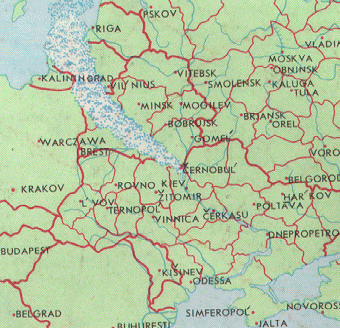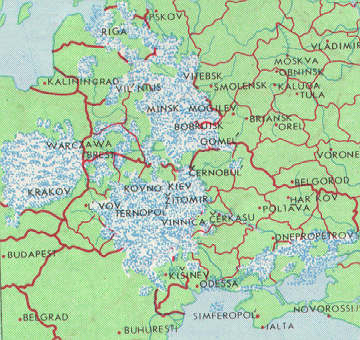 30 hours after the explosion
30 hours after the explosion On April 26, 1986, in the Kiev region, Ukraine, 12 kilometers from the Belarusian border, a catastrophe occurred -- the major breakdown of a power unit at the Chernobyl nuclear power station. By its scale, complexity, and long-term consequences, it is the most severe catastrophe in the entire world history of atomic energy use. As the result of the explosion of the failed reactor, a huge amount of radioactive substances were emitted into the atmosphere. The accident has left its radioactive fall-out trace on 23% of the territory of Belarus, 3778 settlements with more than 2 million people had resided therein; on 4.8% of the territory of Ukraine; and 0.5% of the territory of Russia. The density of contamination with caesium-137 radionuclides constitutes more than 1 Ci/sq.km.
The radioactive trace, left on the ground surface, corresponded to the direction of movement of the radiation clouds. The first days after the accident the radioactive clouds moved North-West, North, and North-East from the Chernobyl nuclear power station near Belarus. By April, 30th, the direction changed to North and East.
 30 hours after the explosion
30 hours after the explosion
After the Chernobyl accident Belarus became a zone of ecological disaster. The situation got worse since the newly emerged areas of radioactive contamination coincided with the formerly existing areas of high chemical pollution. Radionuclides spread from the areas to all regions of the Republic. But the trace of radiation has an extremely uneven, spotted nature. A lot of small areas have both clean and contaminated strips. The area of agricultural lands contaminated with radioactive caesium-137 with a density of more than 1 Ci/sq.km. constitutes 1600 thousand hectares in the Republic, from which more than 200 thousand hectares cannot be used for agricultural purposes. 1685 thousand hectares of forest in Belarus are contaminated with radioactive elements. The catastrophe has affected the destinies of millions of Belarusians. The radioactive contamination of the ecosystem will stifle normal agricultural production and forestry for many decades.
The most affected regions in Belarus are those of Homiel' and Magilyow. Outside the boundaries of the evacuation zone, the high density of contamination with caesium-137 was observed in a number of places. Spots of strontium with levels of radiation ranging from 2 to 3.2 Ci/sq.km. were found in Hoiniki, Vetka, Brahin, and Dobrush districts; few spots of plutonium-238, -239, and -240 with the level of more than 0.1 Ci/sq.km are in Narovlya district. All other regions of Belarus are contaminated to a lesser extent with caesium.
 120 hours after the explosion
120 hours after the explosion
Investigation showed that from the end of 1986, after the termination of blow-out from the reactor's active zone, a marked space of migration of the long-existent radionuclides was not observed. Migration of strontium-137 and strontium-90 in the soil varies. At present the main share of caesium is in the soil layer from 0 to 5 cm. The behavior of strontium-90 and caesium-137 in the system of "soil-plant" has a number of peculiarities in Belarus: usually the induction of strontium in plants is about 10 times higher than that of caesium. But in the light sand and in the peat soils, the migration of caesium is very intensive and can be regarded as comparable to the accumulation of strontium in them.
A lot of work has been done in Belarus in the post-accident period in order to decrease the influence of radiation on people. Measures were taken to evacuate people from the most dangerous districts and provide them with medical treatment. However, the measures are far from being adequate because the extent of the disaster is too great for Belarus to cope with it on its own.
Currently, a great part of the population still resides in the areas of increased radiation. Very often agricultural products from private plots of land are used for food in the contaminated areas. This consumption of tainted foods results in higher radiation doses received by people not only from outer but also from inner exposure.
The Supreme Soviet of the Republic of Belarus passed laws defining the legal and socio-economic status of the radiation contaminated areas as well as the living conditions of the population in them. Nevertheless, the consequences of the accident are so enormous that it is impossible for Belarus to liquidate them alone. The Republic badly needs medicine and contemporary medical equipment. The realization of protective anti-radiation measures requires expenditures exceeding those available to the Republic of Belarus. The Belarusian people, guiltless victims of the horrendous catastrophe, need the help of the international community. International cooperation with the goal of studying and minimizing the effects of radiation serves the interests of the entire mankind.
 This file is a part of the Virtual
Guide to Belarus - a collaborative project of Belarusian
scientists and professionals abroad. VG brings to you the most extensive
compilation of the information about Belarus on the Web.
This file is a part of the Virtual
Guide to Belarus - a collaborative project of Belarusian
scientists and professionals abroad. VG brings to you the most extensive
compilation of the information about Belarus on the Web.
Please send your comments to the authors of VG to
Belarus
History | Statehood | Culture | Law
and Politics | Cities | Nature and Geography |
©1994-04 VG to Belarus
Disclaimer